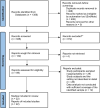Adherence to evidence-based implementation of antimicrobial treatment guidelines among prescribers in sub-Saharan Africa: a systematic review and meta-analysis
- PMID: 37936215
- PMCID: PMC10629154
- DOI: 10.1186/s40545-023-00634-0
Adherence to evidence-based implementation of antimicrobial treatment guidelines among prescribers in sub-Saharan Africa: a systematic review and meta-analysis
Abstract
Background: Adherence to evidence-based standard treatment guidelines (STGs) enable healthcare providers to deliver consistently appropriate diagnosis and treatment. Irrational use of antimicrobials significantly contributes to antimicrobial resistance in sub-Saharan Africa (SSA). The best available evidence is needed to guide healthcare providers on adherence to evidence-based implementation of STGs. This systematic review and meta-analysis aimed to determine the pooled prevalence of adherence to evidence-based implementation of antimicrobial treatment guidelines among prescribers in SSA.
Methods: The review followed the JBI methodology for systematic reviews of prevalence data. CINAHL, Embase, PubMed, Scopus, and Web of Science databases were searched with no language and publication year limitations. STATA version 17 were used for meta-analysis. The publication bias and heterogeneity were assessed using Egger's test and the I2 statistics. Heterogeneity and publication bias were validated using Duval and Tweedie's nonparametric trim and fill analysis using the random-effect analysis. The summary prevalence and the corresponding 95% confidence interval (CI) of healthcare professionals' compliance with evidence-based implementation of STG were estimated using random effect model. The review protocol has been registered with PROSPERO code CRD42023389011. The PRISMA flow diagram and checklist were used to report studies included, excluded and their corresponding section in the manuscript.
Results: Twenty-two studies with a total of 17,017 study participants from 14 countries in sub-Saharan Africa were included. The pooled prevalence of adherence to evidence-based implementation of antimicrobial treatment guidelines in SSA were 45%. The pooled prevalence of the most common clinical indications were respiratory tract (35%) and gastrointestinal infections (18%). Overall prescriptions per wards were inpatients (14,413) and outpatients (12,845). Only 391 prescribers accessed standard treatment guidelines during prescription of antimicrobials.
Conclusions: Healthcare professionals' adherence to evidence-based implementation of STG for antimicrobial treatment were low in SSA. Healthcare systems in SSA must make concerted efforts to enhance prescribers access to STGs through optimization of mobile clinical decision support applications. Innovative, informative, and interactive strategies must be in place by the healthcare systems in SSA to empower healthcare providers to make evidence-based clinical decisions informed by the best available evidence and patient preferences, to ultimately improving patient outcomes and promoting appropriate antimicrobial use.
Keywords: Adherence; Antibiotics prescription; Evidence-based medicine and infection; Standard treatment guidelines; Sub-Saharan Africa.
© 2023. The Author(s).
Conflict of interest statement
The authors declare that this study is free of any competing financial and non-financial interests.
Figures





Similar articles
-
Surveillance of antimicrobial utilization in Africa: a systematic review and meta-analysis of prescription rates, indications, and quality of use from point prevalence surveys.Antimicrob Resist Infect Control. 2024 Sep 11;13(1):101. doi: 10.1186/s13756-024-01462-w. Antimicrob Resist Infect Control. 2024. PMID: 39256804 Free PMC article.
-
Estimated incidence and case fatality rate of traumatic brain injury among children (0-18 years) in Sub-Saharan Africa. A systematic review and meta-analysis.PLoS One. 2021 Dec 30;16(12):e0261831. doi: 10.1371/journal.pone.0261831. eCollection 2021. PLoS One. 2021. PMID: 34968399 Free PMC article.
-
The burden of hospital-acquired infections (HAI) in sub-Saharan Africa: a systematic review and meta-analysis.EClinicalMedicine. 2024 Apr 8;71:102571. doi: 10.1016/j.eclinm.2024.102571. eCollection 2024 May. EClinicalMedicine. 2024. PMID: 38606166 Free PMC article.
-
Bacterial profile and antimicrobial resistance patterns of infected diabetic foot ulcers in sub-Saharan Africa: a systematic review and meta-analysis.Sci Rep. 2023 Sep 5;13(1):14655. doi: 10.1038/s41598-023-41882-z. Sci Rep. 2023. PMID: 37670001 Free PMC article.
-
Prevalence and antimicrobial susceptibility level of typhoid fever in Ethiopia: A systematic review and meta-analysis.Prev Med Rep. 2021 Dec 13;25:101670. doi: 10.1016/j.pmedr.2021.101670. eCollection 2022 Feb. Prev Med Rep. 2021. PMID: 34976707 Free PMC article.
Cited by
-
Perspectives on the Regional Strategy for Implementation of National Action Plans on Antimicrobial Resistance in the WHO African Region.Antibiotics (Basel). 2024 Oct 9;13(10):943. doi: 10.3390/antibiotics13100943. Antibiotics (Basel). 2024. PMID: 39452210 Free PMC article.
-
Status and implications of the knowledge, attitudes and practices towards AWaRe antibiotic use, resistance and stewardship among low- and middle-income countries.JAC Antimicrob Resist. 2025 Mar 25;7(2):dlaf033. doi: 10.1093/jacamr/dlaf033. eCollection 2025 Apr. JAC Antimicrob Resist. 2025. PMID: 40134815 Free PMC article. Review.
-
Inappropriate ceftriaxone utilization and predictor factors in Ethiopia: a systematic review and meta-analysis.Sci Rep. 2024 Oct 23;14(1):25035. doi: 10.1038/s41598-024-75728-z. Sci Rep. 2024. PMID: 39443593 Free PMC article.
-
Supervision, performance assessment, and recognition strategy (SPARS) - a multipronged strategy to strengthen medicines management in Nepal: pilot study methods and baseline results.J Pharm Policy Pract. 2025 Jan 20;18(1):2449043. doi: 10.1080/20523211.2024.2449043. eCollection 2025. J Pharm Policy Pract. 2025. PMID: 39839838 Free PMC article.
-
Surveillance of antimicrobial utilization in Africa: a systematic review and meta-analysis of prescription rates, indications, and quality of use from point prevalence surveys.Antimicrob Resist Infect Control. 2024 Sep 11;13(1):101. doi: 10.1186/s13756-024-01462-w. Antimicrob Resist Infect Control. 2024. PMID: 39256804 Free PMC article.
References
-
- Shrestha P, Cooper BS, Coast J, Oppong R, Do Thi Thuy N, Phodha T, Celhay O, Guerin PJ, Wertheim H, Lubell Y. Enumerating the economic cost of antimicrobial resistance per antibiotic consumed to inform the evaluation of interventions affecting their use. Antimicrob Resist Infect Control. 2018;7(1):98. doi: 10.1186/s13756-018-0384-3. - DOI - PMC - PubMed
-
- Chakaya J, Khan M, Ntoumi F, Aklillu E, Fatima R, Mwaba P, Kapata N, Mfinanga S, Hasnain SE, Katoto P, et al. Global tuberculosis report 2020—reflections on the global TB burden, treatment and prevention efforts. Int J Infect Dis. 2021;113(Suppl 1):S7–s12. doi: 10.1016/j.ijid.2021.02.107. - DOI - PMC - PubMed
Publication types
LinkOut - more resources
Full Text Sources
Research Materials
